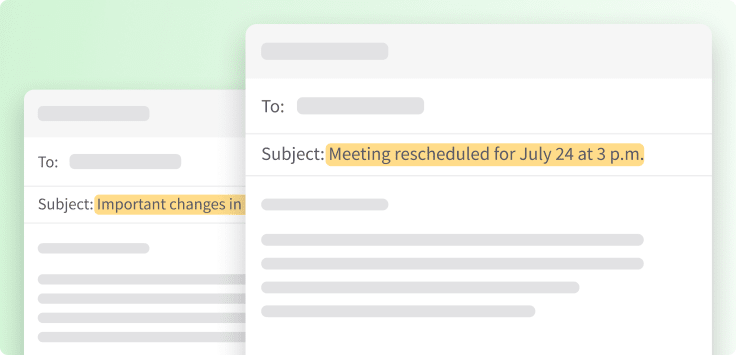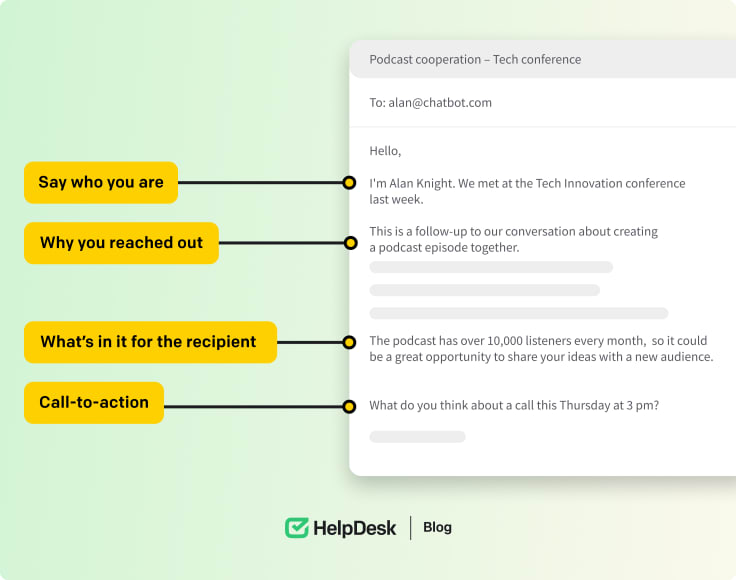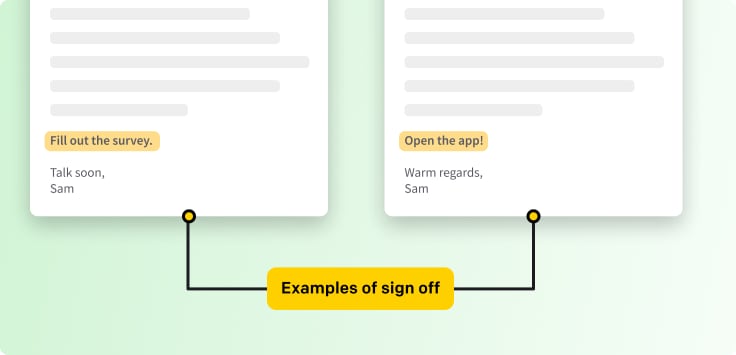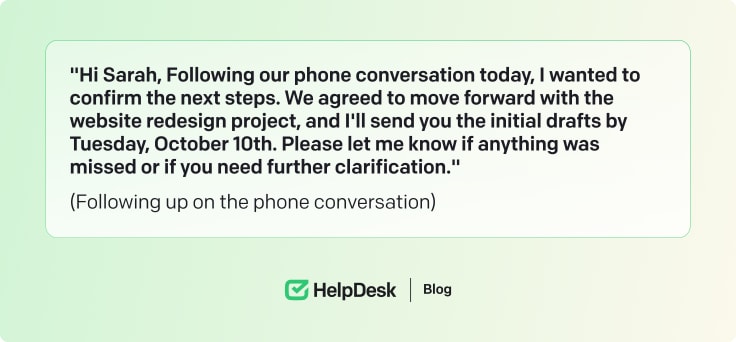Email is a popular form of communication whether you are reaching out to a colleague living across the globe or following up with your customers. Statistics reveal that 62.86% of business professionals prefer to communicate by email (source). It offers convenience, speed, and clarity in professional settings.
However, how you write and format your email significantly impacts the response you may receive. Poorly written emails can lead to misunderstandings, missed opportunities, and even a lack of response.
This is why knowing essential email etiquette is mandatory to create catchy and professional emails.
Crafting a professional email
Typically, a professional email has everything from clear subject lines to a professional tone and the proper structure. Here’s a detailed overview of things you should do to curate a professional email:
Write a clear and concise subject line
Your subject line is the first thing people see, so it should be descriptive, clear, and actionable. Avoid vague language that doesn’t convey your message and confuses the receiver.
Imagine receiving two emails. One has the subject line “Event,” while the other reads “Event at Green Hall at 12:15 pm.” Although both emails aim to inform about the same event, the second subject line offers excellent clarity and is more likely to catch attention and prompt response.
Another crucial email etiquette is to keep the subject line professional and short. Instead of overly long or complex phrases, focus on what matters most.
For instance, instead of writing “Urgent: Your Attention Needed on a Marketing Presentation,” you could simply write “Urgent: Marketing Presentation Review.” This would tell the reader what you want them to do so they can take the desired action.

Choose a professional tone
While being friendly in your email is important, it’s crucial not to cross the fine line between professionalism and sarcasm. Avoid trying to be humorous unless you have a personal relationship with the recipient.
All jokes should be left out because sarcasm can be interpreted differently. What may seem funny to you could offend someone else. It can negatively impact your business, primarily if the email is meant to attract leads or build lasting client relationships. On top of this, we suggest you steer clear of emotional or negative language.
Don’t use phrases like “I’m distraught…” or “It’s frustrating….” as they can create tension and distract the recipient from the real message of the email. Just maintain a professional and courteous tone. To help you understand better, here’s an example of how tone can change the entire message:

Structure and format
Following a consistent structure and format in your email is another email etiquette. Here’s how you can improve your email’s structure to make it more readable:
Start with a formal greeting
Many people don’t know this, but the greeting you use in your email sets the tone of the whole text. Therefore, good email etiquette uses a formal introduction that respects the recipient’s time. For instance, instead of writing “Hi, there,” it’s suggested you should write “Hi, (Name of the person or designation). Some examples you can use are:
-
Hey (Name of the Person)
-
Hello (Name of the Person)
-
Dear (Name of the Person)
Introduce yourself and provide background information
Next, you should introduce yourself, especially if this is your first interaction with the recipient. The purpose is to inform the other person about who you are, what you do, and why you are reaching out. For example, you can say, “Hey, Alex here — the sales manager at Pablo Hub.”
In the background information, briefly explain to the recipient the essential information of the email. Whether it’s for discussing a project update or you are following up on a previous conversation, clearly state the reason for contact.

Sign off in style
Like greetings, concluding your email with proper sign-offs is integral to email etiquette. When you use a sign-off, you give the recipient an indication that you have completed your request and also give off a professional vibe.
Here are some sign-offs that you can use:
For formal emails
-
Best regards
-
Kind regards
-
Warm regards
-
Sincerely
For informal emails
-
Best
-
Thanks
-
Cheers

Best tool to create catchy and informative emails
If you want to streamline the process of writing a professional email, an AI HelpDesk Email Generator is a sigh of relief. All you have to do is enter a prompt describing what you want to convey in the email.
Is it an email targeting new leads or a collaborative email to your colleague? After giving the input, hit the generate button. The AI HelpDesk Email Generator will then use machine learning and natural language processing to provide you with a human-like email that’s concise yet clear and free of all errors.
If you want to add attachments, you can add them to the input with names, and the AI email generator will incorporate them professionally. The best part is that it can also personalize your emails, increasing your open rate by 26% (source).
Learn more about crafting business emails with the HelpDesk Learning Space. 🧑🚀Join the Business Writing Course and become a PRO in writing messages. 🚀

Effective communication
The main goal of sending emails is to communicate with others effectively. If you succeed, your message may be addressed. Following are some tips that help you avoid this:
Responding to emails and follow-ups
Responding promptly to emails is important for email etiquette. When you reply to colleagues promptly, you can be assured that everyone is working smoothly on the given task without any confusion.
However, when sending a follow-up email, you can leave out the greeting part and avoid using overly formal language.
Many advanced tools, like HelpDesk, ActiveCampaign, and Mailchimp, enable you to schedule follow-up emails. The emails are sent to the recipients automatically in a professional tone, saving you from the hassle of manually tracking every conversation.
Discover more about follow-up emails and learn how to send them. 🔥

Reiterating phone conversations
After a critical phone conversation, especially with a colleague or potential lead, it’s an important single-email etiquette to reiterate those points in the email. It helps clarify misunderstandings and ensure everyone is on the same page, leading to company success. A good example of reiterating phone conversations is:

Email etiquette in different contexts
Let’s look at an overview of email etiquette for different contexts.
Emailing someone you don’t know
When sending an email to someone for the first time, it’s important to maintain high professionalism. Use formal greetings and signatures, and avoid using slang or casual language that may be offensive.
Address the recipient by their first and last name, for example, “Dear Peter Smith, Marketing Manager at AB Digital Services”. Keep the email concise and clear, and avoid leaving room for ambiguity that can lead to misunderstandings.
Email listservs and discussion groups
You should follow email etiquette in email listservs and discussion groups so your message is understandable and respectful to everyone.
Always stay on topic, use clear subject lines, and list only the necessary information to prevent group members from being distracted from the group’s and email’s actual purpose.
Do not, in any case, use inflammatory language that can hurt others’ feelings. Even in debates, you must stay calm and constructive.
Additional tips on email etiquette
Some additional tips on email etiquette that can make your emails look more professional are:
Proofreading and editing
Properly proofread and edit your emails before sending them to avoid confusion and common mistakes. Here are the things that you should do in this regard:
-
Use Grammarly: Manually finding grammatical errors can be quite a hassle. Therefore, you can use tools like Grammarly to streamline your proofreading process. Its outlines are grammatical errors in red so that you can fix them right away. Other than that, this tool helps identify awkward sentences that are disturbing the flow of your content. You can accept suggestions to enhance the clarity of the email before you hit send.
-
Correct spelling mistakes: Spelling can make your emails look unprofessional and undermine credibility. So, remember to scan and double-check the email for errors, especially in the names of persons and places and any particular terms that are important to understand the context of the email.
-
Use punctuation correctly: Punctuation may seem like a small thing, but it can hugely impact the final delivery of your email. Yes, it’s true! Misplaced commas and missing full stops can change the whole context of the email, leading to confusion and poorly completed projects. So, using punctuation marks correctly is essential to maintain the intended tone and message. Here are some fundamental rules:
-
Use commas to separate items in a list.
-
Make sure every sentence ends with a punctuation mark.
-
Don’t forget to add a comma to punctuate your salutations properly.
-
Most importantly, use standard fonts throughout the email.
Using BCC and CC
Understanding the concept of BCC and CC is important to have email etiquette.
BCC
When you blind carbon copy (BCC) someone in an email, the recipient receives a copy of the email without other recipients knowing. It’s good when you have to protect other people’s privacy, and you can also use it to politely remove people from inbox threads.
CC
When you carbon copy (CC) someone in an email, they can see the email addresses of the other recipients in the CC field. It’s good to keep everyone in the conversation loop; however, we suggest you tick the “Reply” button instead of the “Reply All” button.
Summary
Before writing your email, you should be aware of all email etiquette and incorporate them into the final draft so it captures readers’ attention and provides you with a quick answer.
Which tool can you use to automate email creation and management? HelpDesk is the ultimate one-stop shop. It offers features like AI-powered email generation, ticketing, and message capabilities that help you in email follow-up, saving plenty of time. So why wait? Get the free trial now and have your emails professionally delivered!


